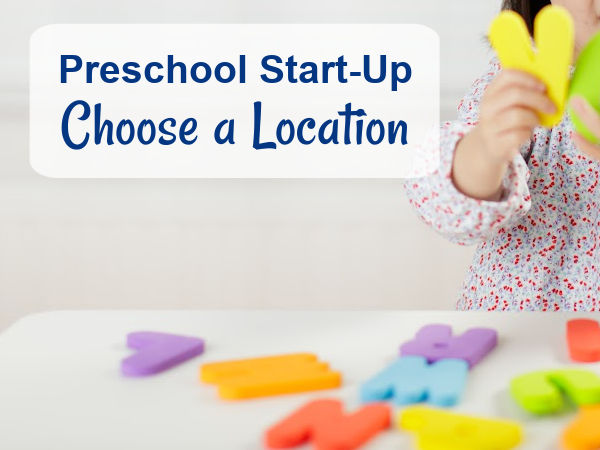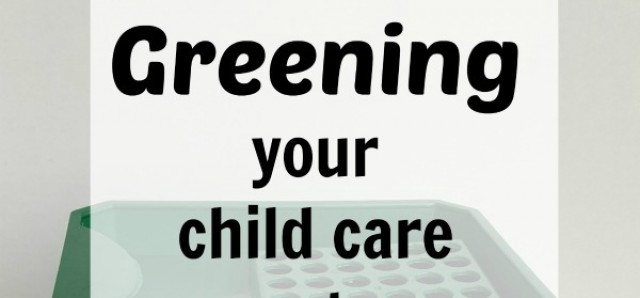How to Choose Your Best Preschool Start-Up Location
The building where you operate your preschool is an important part of the program you deliver. Explore a variety of options in order to choose the best environment to start your preschool or day care.

Privacy and Disclosure for information on cookies and affiliates
The building that houses your child care program is where all the nurturing, play, and learning take place. Deciding on a location and structure is an important step in setting up an early learning program. These tips can help you on your journey to becoming a facility owner or manager.
| Disclaimer: I am not an authority on the subject of choosing a facility for a preschool start-up. I draw from my experience as an early learning teacher and facility owner. For the purpose of this discussion, I refer to websites in my province as helpful examples of topics discussed in this article. |
Child care centers can be found in various buildings, including a church hall, a private home, and a public school. All these setups operate with the same goal – to provide quality child development experiences for early learners.
The special circumstance of an at-home, privately owned, business is often pursued by budding entrepreneurs. Self-employment is not for everyone, but it's worth consideration as you explore the possibilities for opening your preschool facility.
Whether a part-day or full-day program, preschool start-ups need a home, and these tips will help you find the best fit for your program.
Preschool Start-Up: Choosing a Facility
A suitable facility will depend on licensing requirements, as well as your program goals and business model. Also, there are the prospects of starting the facility as a privately owned facility or as a non-profit facility.
The following categories will help you research your possible location.
1. Neighborhood
The neighborhood where you will operate your business can be an important part of your research into finding a suitable location. You'll bring your preferences and expectations to the decision making process.
- You might want to be near an elementary school, a shopping district, or a business area.
- You might want to be inside, or within walking distance of, a residential area.
- You might want to accommodate working parents.
- You might prefer urban or rural.
Your search for a location will depend jointly on the neighborhood and the availability of a facility.
Once you find a possible option, you'll want to examine both the outdoor and indoor spaces of the building you are considering, to assess the structure's ability to accommodate your program goals and the needs of the children in your care.
Related: Determine Your Program Goals for An Early Learning Program
2. Structure
Options for a building for a child care center include the following.
- Rent or buy a stand-alone or semi-detached structure.
- Rent space in a community building such as a recreation center or town hall.
- Operate in conjunction with a public or private school in designated classrooms or other spaces.
- Make use of space in your home.
An self-employed preschool owner will often make use of home space to run the business. Depending on the license issued for the facility, similar requirements exist for the indoor and outdoor environments.
Outdoor Environment

Explore the area as you ask important questions.
What is the competition in the area you're considering? Is it a convenient location for parents and staff?
Is there an outdoor play area? Does if have approved play equipment, or room to install apparatus if necessary? (Part-day programs may not require play equipment on site).
Is there adequate parking for parents and visitors?
Are entrances accessible for all abilities?
With any building, there will be local regulations such as zoning by-laws, and licensing and parking restrictions to investigate, as you pursue a possible location. You’ll also want to inquire whether services such as snow removal and garbage collection are met by the municipality or must be negotiated by the owner.
Insurance costs, and coverage limitations, are important considerations, whether your choose a space in your home, or another option.
- Rent or Buy
If you are exploring structures with an option to buy or rent, consider the age of the building and its condition. You can get professional advice on costs of repairs and upgrades that might be needed, such as siding, windows, and roofing.
A large scale building may allow for greater enrollment and staffing, as well as access to government funding if it's a non-profit facility.
Take into account traveling to and from the location, as well as extra time required away from home to clean and set up centers; hold parent-teacher meetings; conduct an open house; interview new clients and staff.
- Shared Space
A community building that is fully operational may have space for a classroom, and come with on-going costs, such as taxes and maintenance, already in place. Upgrades or alterations may be needed to meet licensing requirements. Also, there may be some conditions regarding sharing of the expenses.
- Home-Based
If you are considering a space in your own home, determine whether renovations will be required for licensing purposes. These upgrades could include fencing for the outdoor play area, or adding a second exit to the space you intend you use for the preschool.
A home based preschool may entail smaller class sizes, and smaller staff support, and more flexibility for the owner.
The benefits of an at-home preschool facility include: no travel time; the ability to clean, do paper work, and prepare play materials at your convenience; being available at lunch and after school for family, if you operate a part-day program.
Indoor Environment

Here are a few issues to take into consideration when investigating the interior of a facility.
Are there adequate bathroom and kitchen facilities?
Is there proper ventilation and working windows?
Is there sufficient lighting in place? Is there an option for soft light for naps?
You'll also want to consider the ability of the facility to meet your program requirements. You will need enough space to outfit the room(s) with suitable furnishings and finishes, and deliver the various scheduled events you hope to provide.
- Activities such as gross motor and small group play require large amounts of open floor space
- Licensing regulations can dictate the amount of square-footage-per-child and staff-to-child ratio.

Consider the ability of the interior space to accommodate the layout of furnishings and play materials.
Is the space open concept, or divided up by walls and hallways?
Can a single room be separated into areas for different activities such as playing, eating, and circle time?
Do windows and doorways interfere with wall space where you might want to place shelves or other furnishings?
- Play areas
Separated play areas, or centers, are a common setup in early learning classrooms. Each play area has related materials, with shared learning goals, to support creativity, cognitive skills, fine motor skills, independent thinking and working.
Furniture placement helps to define the individual play areas (sometimes called corners, or stations). Low cube shelving, kid-sized tables and chairs, or props such as a puppet theater or play kitchen, can be situated to serve as dividers to separate individual spaces.
Centers can include:
- art area with easel, smocks, and paints
- block corner with containers for blocks and related toys such as construction vehicles
- dramatic play area with a play kitchen, dolls, and dress-up clothes
- reading corner with comfy seating (chairs, mats, or pillows) and accessible books
- sand table; light table; water table
Some furniture or props may be portable, and moved about the space from time to time, while others require fixed positioning in the room (i.e. book shelves, light table).
Floor coverings can also be used to signify different learning spaces: a carpeted area for circle time; a washable floor for the art center and water play. Area rugs or individual mats can also be added to define play spaces. For example, small mats can be placed in a semi-circle to accommodate students at circle time.
My at-home classroom was an open space designed to accommodate all daily activities including free play (independent play). Low shelving units separated play materials in centers around the perimeter of the room. Kid-size tables and chairs were positioned in the middle of the room to be used alternately for crafts, snacks, and small group activities. A corner of the room with individual small mats was a comfortable circle time area.
- Separation of areas for students and staff
STUDENTS...
.....need space to play, to eat, to wash hands, and to interact with others in a safe and inviting environment.
.....need appropriately sized chairs and tables, accessible shelving for play materials, and labeled cubbies and/or coat hooks for independent care of belongings and outerwear.
STAFF MEMBERS...
.....need a place to store personal belongings.
.....need shelves or cupboards that are out of students' reach but accessible when items are required (i.e. first aid kit, props for circle time, mobile phone).
Consider whether there is space to store craft supplies as well as extra toys and materials that may be rotated in the play area throughout the school term.
You might also want a private office space if possible, or at least a secure place for a file cabinet or cupboard to hold confidential records.

Opening an early learning center is a rewarding career opportunity that involves many variables, beginning with the building that houses your business. Choosing the location is a major part of the start-up process.
With careful consideration, and a bit of leg work, you'll find the optimum space for preschoolers to play, learn and grow!



